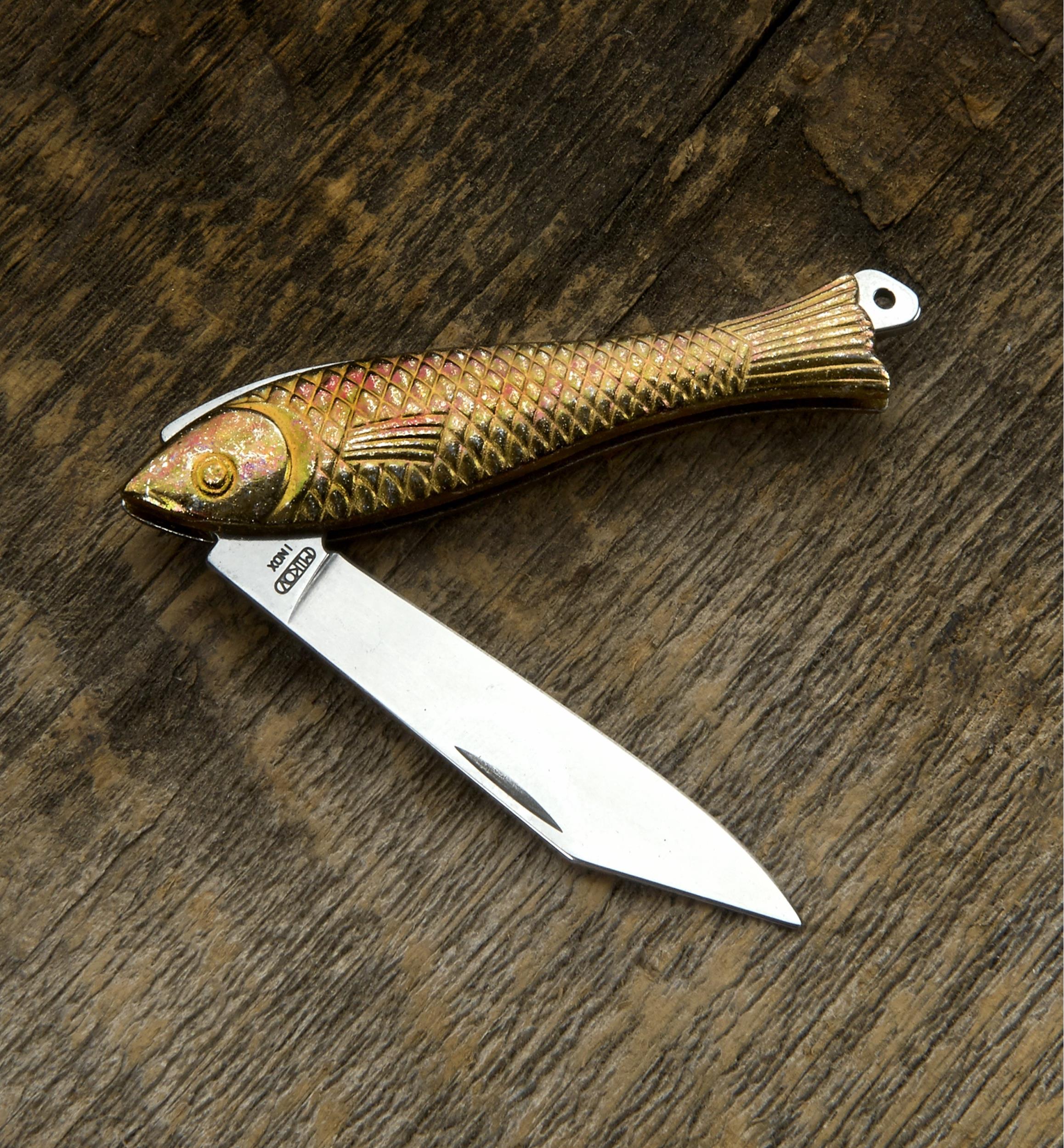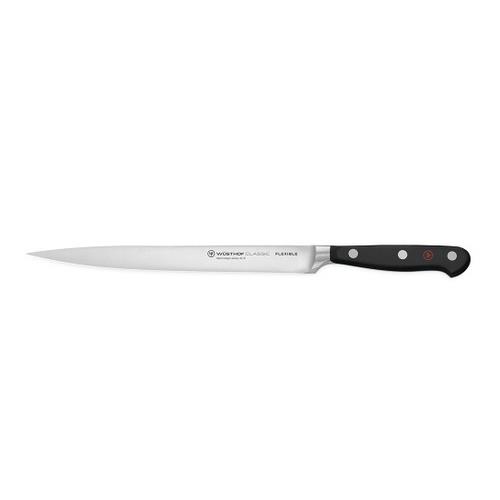The history and evolution of the fish knife
Wiki Article
Discover the Vital Features to Look for in a Top-Quality Fish Knife
When choosing a fish knife, a number of essential features require attention. The blade material significantly impacts sturdiness and intensity, while flexibility plays an important role in precision. Furthermore, the deal with style influences convenience during extended use. Side retention and security features are also essential for sensible use. Comprehending these aspects will certainly guide consumers toward making an educated choice, yet the nuances of their significance might not be promptly clear.Blade Product and Construction
The performance of a fish knife mostly depends upon its blade material and construction - fish knife. High-quality fish knives commonly feature blades made from stainless steel, high-carbon steel, or a mix of both. Stainless-steel is preferred for its deterioration resistance and low upkeep, making it perfect for freshwater and deep sea environments. High-carbon steel, while vulnerable to rusting, uses superior intensity and side retention, appealing to those who prioritize reducing performanceThe building and construction of the blade also plays a crucial role in its efficiency. Full-tang blades, which prolong the whole length of the handle, supply improved strength and balance. On the other hand, partial-tang blades might compromise durability. In addition, the density of the blade must be taken into consideration, as thinner blades enable extra specific cuts, vital for delicate fish filleting. Inevitably, a well-constructed blade, using the best products, is essential for achieving the ideal results when preparing fish.
Blade Versatility and Size
Blade adaptability and size are essential variables that substantially affect the performance of a fish knife. A versatile blade enables specific cuts and the capacity to steer around bones and skin, making it crucial for filleting fish effectively. The correct amount of flexibility can improve control, enabling the individual to achieve clean, smooth cuts with marginal initiative.In regards to length, fish blades normally vary from 6 to 9 inches. A longer blade is helpful for bigger fish, giving the reach needed for efficient filleting. Conversely, a shorter blade offers maneuverability, making it appropriate for smaller fish or intricate jobs.
Inevitably, the selection of adaptability and size should line up with the details angling demands and preferences of the customer. A healthy mix of these attributes guarantees optimum efficiency, improving the overall fish prep work experience.
Take Care Of Layout and Comfort
A properly designed deal with is necessary for making sure convenience and control when using a fish knife. The handle should fit firmly in the hand, enabling for a company hold throughout detailed jobs such as filleting or skinning fish. Products like rubber, timber, or composite provide various levels of convenience and grip, affecting the user's experience.Ergonomic functions are additionally important; contours that adhere to the natural form of the hand can reduce exhaustion throughout extended use. Additionally, the manage's structure plays a substantial duty in preventing slippage, specifically when working with damp hands.
Weight distribution is one more element that adds to the overall balance of the knife, improving ability to move. A comfy take care of design not just improves efficiency but likewise advertises safety, as a safe and secure grip reduces the danger of accidents (fish knife). Ultimately, a thoughtful handle style can significantly boost the efficiency of a fish knife in cooking applications
Side Retention and Developing
While making use of a fish knife, preserving a sharp side is important for attaining clean cuts and exact filleting. A quality fish knife need to exhibit exceptional side retention, enabling it to remain sharp with numerous usages. This particular is frequently established by the sort of steel used in the blade; high-carbon stainless steel is often chosen due to its equilibrium of firmness and corrosion resistance.
Safety Attributes and Sheath Options
Various safety attributes and sheath options are necessary considerations when selecting a fish knife. A secure and ergonomic deal with reduces the threat of slides during use, enhancing customer security. Textured grips and finger guards further avoid mishaps, allowing for much better control while filleting fish.In addition, a blunt suggestion can reduce the danger of leak injuries, making it a safer option for beginner users.
Sheath choices also play a critical role in safety. A properly designed sheath safeguards the blade, preventing unintentional cuts when the knife is saved or transported. Sheaths made from durable products, such as nylon or tough plastic, deal included protection against ecological elements.
Some sheaths include belt clips or loopholes, guaranteeing the knife more info is conveniently obtainable while remaining secure. Ultimately, focusing on safety functions and sheath alternatives contributes dramatically to the total performance and individual experience of a fish knife.
Regularly Asked Concerns
What Is the Best Brand for Fish Knives?
The most effective brand for fish knives commonly varies by preference, but popular names like Wüsthof, Victorinox, and Shun are often suggested for their sharpness, craftsmanship, and longevity, making them leading selections amongst cooking enthusiasts and specialists alike.Can Fish Knives Be Used for Various Other Kinds Of Fish?
Fish blades can without a doubt be utilized for other sorts of fish. Their layout and sharpness make them versatile enough for various fish varieties, improving the general experience of filleting and preparing different kinds of fish and shellfish.
Just how Do I Tidy and Keep My Fish Knife?
To cleanse and keep a fish knife, wash it with cozy water after usage, gently scrub with mild soap, completely dry thoroughly, and store in a safety sheath to avoid damage and corrosion. Routine developing is essential.Exist Fish Blades Specifically for Left-Handed Users?
Yes, there are fish knives created especially for left-handed individuals. These knives include reversed blade angles and ergonomic takes care of, making certain comfort and performance for left-handed individuals while filleting and preparing fish. Quality options are readily available from different manufacturers.What Is the Price Array for Quality Fish Knives?
Quality fish knives normally vary from $20 to $150, depending on materials, brand online reputation, and craftsmanship. Higher-end options may feature customized layouts and superior comfort designs, while economical options still offer acceptable performance for casual customers.The effectiveness of a fish knife greatly pivots on its blade product and building. Premium fish knives generally include blades made from stainless steel, high-carbon steel, or a mix of both. Blade adaptability and size are vital factors that substantially influence the efficiency of a fish knife. Fish knives can undoubtedly be used for other kinds of fish. These knives feature reversed blade angles and ergonomic manages, making sure convenience and efficiency for left-handed people while filleting and preparing fish.
Report this wiki page